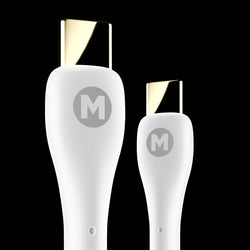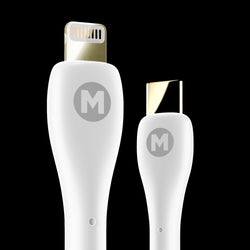
A Complete Guide to Understanding Lithium-ion Batteries
Lithium-ion batteries have dominated the tech scene, overtaking nickel-metal-hydride as the most popular rechargeable battery used in our devices. Lithium-ion batteries use advanced technology and electrochemistry to give maximum power. They’ve been praised for their reliability and their longevity when compared to other battery types.
But how do lithium-ion batteries work and what makes them so much better than other batteries? As technology experts, we at MAGFAST have put together this extensive guide to help you understand lithium-ion batteries.
What is a lithium-ion battery?
A lithium-ion battery is a type of rechargeable battery that’s commonly used for a range of tech products. As the name suggests, they use lithium ions to store and transfer power. They’ve been praised due to their reliability and, although they have a high cost per unit when compared to other battery types, they’re so popular due to their high energy density.
What are lithium-ion batteries made of?
A lithium-ion battery is made up of four main parts. In every lithium-ion battery, there is an anode and a cathode. The anode stores the positively charged lithium ions and electrons and allows the electric current to flow out to an external device. The cathode is where the positive lithium ions come from.
Between the anode and the cathode is a physical barrier, called a separator, which stops the electrons from flowing inside the battery. Lastly, the battery will contain an electrolyte, which is what allows the lithium ions to travel between the cathode and the anode.
How do lithium-ion batteries work?
When the lithium ions move, free electrons are created in the anode of the battery. These electrons are the charge that can then be transferred from the battery to the device that needs charging.
Lithium-ion battery packs will also contain a small computer that supervises the charging process, as well as temperature sensors that check the temperature. If the battery gets too hot at any point, the computer will shut down the charging process until it cools down.
What are lithium-ion batteries used for?
Lithium-ion batteries are commonly used in consumer electronics. Devices such as smartphones, laptops, digital cameras, tablets, and handheld game consoles all use lithium-ion batteries. The power banks you would use to charge these devices, like MAGFAST chargers, also use the same battery type.
Rechargeable power tools also use lithium-ion batteries. Equipment such as cordless drills, sanders and hedge-trimmers all utilize this type of battery.
The other main category of products that use lithium-ion batteries is electric vehicles. Electric cars, hybrid cars, electric scooters and electric bicycles all use a rechargeable lithium-ion battery, albeit on a much larger scale than that used in other consumer electronics.
How to charge a lithium-ion battery
Charging a lithium-ion battery is super simple. You may have heard that you need to let a battery drain to 0% before you charge it, or you should never leave your device plugged in when it reaches 100%, as the battery will overcharge and overheat, but with lithium-ion batteries you don’t need to worry about this.
Generally, it’s better not to let lithium-ion batteries get to 0%, as this can cause them to degrade faster. Instead, a shallow charge and discharge can be better. This means charging your device when it falls to around 50% battery, and not always charging it to full. However, it can be good for the battery to let it fall to 5% periodically, so the internal computer can recalibrate.
What happens if you completely discharge a lithium-ion battery?
Completely discharging a lithium-ion battery can render it useless. However, just because your device is displaying 0% battery, it doesn’t mean it is fully discharged. As anyone who has ever let their phone run out of battery knows, it’s possible to recharge it again even if it has completely lost power.
However, the problem with letting a lithium-ion battery fall to 0% comes when you leave it at 0% for a long period. If you store a device with a lithium-ion battery at 0%, after a few months you may find that it will be impossible to recharge it. This is why it’s advised to always store devices with some charge in them.
You should also note that due to the computer that lithium-ion batteries use to monitor the charging process and the battery, they will always use a small amount of their own power. So, if you’re storing a device for a long period, it might be beneficial to top it up with a charge every now and then, to ensure it will keep working when you need it. We’ll discuss more about the best way to store your lithium-ion batteries below.
What happens if you overcharge a lithium-ion battery?
Lithium-ion batteries contain a small computer that monitors the battery capacity, the voltage and the charging process. So, if you’re using a power bank that has a lithium-ion battery, it will track the charge and will stop charging when the device reaches 100%. This stops the device from getting damaged through overcharging, even if you leave it plugged in.
What are the advantages of lithium-ion batteries?
Lithium-ion batteries are popular because they bring many benefits. One advantage of lithium-ion batteries is that they’re much lighter than their counterparts. This means they can hold the same charge as another type of rechargeable battery, but lithium-ion will weigh a lot less. It makes them perfect for portable devices like smartphones and power banks.
Related to their weight, another benefit is that lithium-ion batteries have a high energy density. They are capable of holding a lot of power. For example, a lithium-ion battery can typically hold around 150 watt-hours of electricity in 1kg of battery. A nickel-metal-hydride battery, often used for rechargeable toothbrushes, electric razors, and some hybrid vehicles, can only hold 100 watt-hours per kilogram. A lead-acid battery, commonly used in car batteries, can only hold 25 watt-hours per kilogram.
This is why we’re able to design MAGFAST Extreme, a high-capacity power bank that has enough power to keep multiple devices going for days. Plus, Extreme is lightweight enough to travel around with you in your backpack or briefcase, thanks to the energy density of the lithium-ion battery.
Another advantage of lithium-ion batteries is that, unlike some other battery types, it does not suffer from the “memory effect”. The memory effect can occur in some batteries that are routinely charged up before the capacity reaches 0%. The battery “remembers” the shorter cycle and so may reach 0% quicker on its next use. Lithium-ion batteries do not have this issue, and so they do not need to be discharged to 0% before they’re charged again.
Another benefit of lithium-ion batteries is that, while they will self-discharge a small amount, it is much less when compared to other battery types. Generally, lithium-ion batteries will self-discharge around 5% per month, whereas a nickel-metal-hydride battery will self-discharge around 20% per month.
How long do lithium-ion batteries last?
Lithium-ion batteries have different capacities and characteristics, including their lifespan. But generally, the minimum lifespan of a lithium-ion battery is around 2,000 charging cycles. However, with the right care, lithium-ion batteries can extend to 3,000 charging cycles.
How to extend the life of a lithium-ion battery
There are a few ways to extend the life of a lithium-ion battery, which will affect how you use the battery as well as how you can store it.
The charging speed you use will affect the battery life. So, while we love fast charging when we’re in a rush, unfortunately this will always impact the battery more than slower charging speeds. This is why we designed MAGFAST chargers to have multiple ways to get power in and out.
Our ‘snap-to-charge’ technology uses the standard charging rate, to help preserve your battery. Simply snap any MAGFAST charger onto another for a gentle and efficient charge. When you need some more speed, you can charge the MAGFAST chargers via USB-C. Power banks that only rely on USB-C to receive power could degrade more quickly due to the constant high intensity.
Another factor that will affect the battery life of a lithium-ion battery is the number of charging cycles it goes through. Every time a lithium-ion battery goes through a charging cycle, it will degrade ever so slightly. This is why charging it when it gets to around 50% can help to extend the battery life, when compared to letting it regularly get to 5% or lower.
How to store a lithium-ion battery
How you store the lithium-ion battery will have an impact on its battery life. You should avoid storing it at high temperatures. Leaving lithium-ion devices in temperatures over 86F (30C) can cause them to degrade much faster than at lower temperatures. For this reason, you shouldn’t leave your lithium-ion device in a hot car or in the sun.
If you’re storing your lithium-ion battery, it can be beneficial to leave it in the refrigerator (but never in the freezer, as this is too cold).
As we’ve mentioned, the amount of charge you store your device with will affect the battery life. You shouldn’t store your lithium-ion battery with 0% battery, as this could result in your being unable to recharge the battery again. However, you should also avoid storing it at 100%, as this can also degrade the battery.
Storing your lithium-ion battery at around 40% battery and between 41F to 59F (5C to 15C) is optimal to extending the battery life. You should periodically top up the battery to keep it around 40%.
Benefit from lithium-ion with MAGFAST
MAGFAST power banks utilize lithium-ion batteries, bringing all the benefits of a lightweight design and high-density energy. It means our power banks can keep you and your devices going for days, with multiple ways to get power in and out.
Our power banks feature Qi wireless charging as well as cabled charging, supporting USB-A, USB-C, micro-USB and Apple Lightning. They’ve been designed for every part of your life, to power your past, present and future devices.
Attend our demo to find out everything you need to know about our innovative premium chargers. Everyone who watches this free online demo will be entered into our prize draw to win $1,000 of tech gear!
- A Complete Guide to Understanding Lithium-ion Batteries
- What is a lithium-ion battery?
- What are lithium-ion batteries made of?
- How do lithium-ion batteries work?
- What are lithium-ion batteries used for?
- How to charge a lithium-ion battery
- What are the advantages of lithium-ion batteries?
- How long do lithium-ion batteries last?
- How to extend the life of a lithium-ion battery
- Benefit from lithium-ion with MAGFAST
America's highest-rated smart phone cable ...



